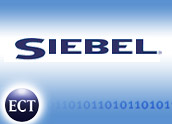
The annual meeting of the North American Siebel user group is a big deal, and last week’s convocation in Los Angeles played true to form. In addition to the usual swarm of product announcements, education sessions, and the partner pavilion, it was new CEO Mike Lawrie’s first opportunity to address the group and meet with customers, press and analysts on a grand scale.
Lawrie took over from founder Tom Siebel in June, and for much of his brief tenure he has been busy taking stock of the company, building his team and working with them to assess the company and market and begin pointing the company and the industry in a new direction. Despite his brief time in the saddle, the results of the Lawrie’s early efforts could be seen in last week’s event.
Some company initiatives, such as continuing a major push in analytics, had been underway prior to Lawrie’s installation, and others — such as the company’s renewed emphasis on global services detailed by new SVP of global services Eileen McPartland — seemed to be outlines that would be filled in over the coming months. There was also a business intelligence conference within the conference, and much that was announced came from that quarter. Here are some observations.
Siebel BI Summit
For the last two years, Siebel has been accelerating its efforts in the application of business intelligence to all parts of CRM. According to IDC, Siebel leads the market in CRM analytics. Internally, the analytics group generated more than $120 million in revenues in 2003, ahead of all other departments. Siebel’s acceleration continued with the company’s first “BI Summit,” held within the user group meeting. Group VP and general manager of Siebel analytics, Larry Barbetta, unveiled a new suite of customer analytics — Siebel Enterprise Analytic Applications — designed to bring real time analysis to every facet of the business.
The applications are targeted at most major enterprise areas, including sales, service, marketing, finance, procurement, human resources, operations/supply chain and executive management. Interestingly, these applications work with Siebel data as well as with data from some of the company’s main rivals, including SAP, Oracle and PeopleSoft.
Siebel was wise to go after the analytics market when it did. Real-time analysis is important to future CRM success for many companies, and IDC projects that the customer analytic applications market will be worth $1.5 billion by 2008.
But all of the buzz surrounding the announcements can be reduced to a few key facts. We have spent several years wringing cost out of the CRM equation, and the next area to look for success has to be in generating revenue. That means being timelier with the right products and services that generate more revenue, and analytic applications can play a big role. That’s why this announcement was important to Siebel and its customers.
Global Services Initiative
About two years ago I wrote a white paper on satisfaction within the Siebel customer base. One of the interesting findings from my research was that only about half of Siebel customers said they performed a baseline study of their business prior to buying and deploying CRM. Further research later confirmed that Siebel customers were hardly unique, but there was an unmistakable correlation between effective self-analysis, planning and positive results.
At the user group meeting Siebel both acknowledged this reality and proposed a solution. The acknowledgement came in the form of a survey conducted by the company that indicated most customers thought Siebel did a good job of delivering technology but not so well at earlier aspects of a deployment, such as vision creation. And this was despite the fact that the company offers a number of service products along a continuum that starts at vision creation and goes through to project completion. What seemed to be missing was a unified framework to tie it all together.
The solution, according to new SVP for Siebel global services, Eileen McPartland, is a fresh start with a six-part “blueprint” for success. McPartland is a good choice to lead this effort, having done similar work at SAP and having led Gartner’s research. She brings a lot of experience to the job and a clear vision of how to do it.
McPartland was quick to emphasize that Siebel is not getting into the services business or looking to muscle out any partners. The impression was rather of someone distributing new hymnals so that all parties could be on the same page. If nothing else, this will provide the customer with new clarity of purpose during the process of successfully deploying CRM.
More Announcements
There were simply too many announcements to cover in one column. Siebel made sure there was something for everyone, including more functionality for all horizontal and vertical products, better metrics for version 7.7 compared to prior releases, a peek at version 7.8, and greater functionality for the OnDemand versions. The company also made sure to emphasize that it offers products for all sizes of customer as well as multiple deployment options.
Perhaps the most interesting of the product announcements was the commitment to exploring custom requirements. That was a big deal because customization has previously been frowned upon, suspected of corrupting the system and causing headaches during upgrades. But the new architecture — introduced several releases ago and now stable — makes the idea of custom development more routine. It also signals a new direction in which Siebel is trying to provide better fit to its largest customers.
Meet the New Boss
Mike Lawrie stepped into a fish bowl when he walked on stage in L.A. Although he is still relatively new in the position, knowledgeable observers were not simply measuring him in comparison to his predecessor — they were also comparing him to the size of the job ahead.
In his debut, the former IBM executive chose to be measured and conservative, more the avuncular enabler of CRM solutions than the charge-ahead salesman. That might work well as CRM and Siebel enter a new phase, but I would have preferred a little more energy as he set out the big picture that subsequent speakers like Eileen McPartland, Larry Barbetta, David Schmaier and others would fill in.
Despite the lack of fireworks, Lawrie’s influence could be seen in more subtle ways. Under his guidance the company has brought in people like McPartland to enhance its services offerings, and Siebel’s analytics attack has accelerated. Lawrie has communicated an interest in getting closer to the customer, and he’s making the right moves to make that happen. Most fish bowl watchers agree it won’t be fair to judge him in any greater detail until next year’s conference.
Analysis and CRM
Ten years ago Don Peppers, Martha Rogers and Harvard Business School professor Kim Clark described the future of customer interactions as a “learning relationship.” The learning relationship would replace transaction-driven interactions with something that looked a good deal more like a true relationship between equals. Information would be the primary currency in these transactions because, along with selling and servicing products, a lot of information would change hands.
Vendors would get to know their customers and the consumer would give greater loyalty to the vendors who appeared to be listening and reacting to customer needs. But to do all that, applications would need to gather reams of customer data and analyze it to look for patterns of need and satisfaction and then alert human users to specific conditions and opportunities.
All that was required to achieve this vision was a complete rewrite of all customer-facing client-server applications in existence, and then some. The new applications would be Web friendly and would have embedded business rules and analytics engines. And they would have user interfaces that were easy and intuitive both for the people who used them and for those who maintained them. That was a tall order.
But as we approach the ten year mark, much of what was called for has been delivered by Siebel and others. What seems to be missing, though, if last week was any guide, is the conscious acknowledgement of the accomplishment. Too often we get fixated on the technology details and forget to look at the bigger picture. There was an unexploited opportunity last week to take a victory lap and point to the horizon as well as celebrate the technical accomplishments of the moment.
Perhaps the brightest spot may have been Eileen McPartland’s unveiling of a new global services program that will ultimately help Siebel users become more successful with their customer interactions. That was a good start and a move in the right direction.
Denis Pombriant is former vice president and managing director of Aberdeen Group’s CRM practice and founder and managing principal of Beagle Research Group. In 2003, CRM Magazine named Pombriant one of the most influential executives in the CRM industry.














































